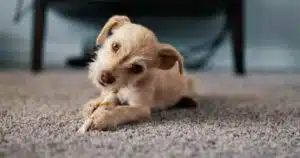
When training a puppy or dog new skills, using positive reinforcement (ie: rewarding the desired behaviour) works best.
It is also important to know how to use a ‘Schedule of Reinforcement’ correctly during the different stages of training a puppy or dog with the aim of strengthening the behaviour you are after.
When training a puppy or dog you need to find what ‘reward’ motivates them most to do what you want them to do. This can include verbal praise, treats, pats, games, etc.
Motivation really is the key to achieving high levels of training and the wrong type of reward, or too much or too little, of motivation will significantly affect performance.
For puppies and many dogs, treats are definitely top of the list so it’s important we do this responsibly using very small pieces of treats (always look for meat as the first ingredient like in the Vitapet treats) and ensuring treats make up no more than 10% of your dog’s total required daily calorie intake.
Remember though when training a puppy, what motivates your dog can change from day to day, hour by hour even.
For example, when training a puppy or dog it is best to avoid feeding them first if they are usually best motivated by food or treats, as this may wane if they are full, and you may struggle to keep your dog interested in the training or improving their skills.
That’s why it is really useful for you to understand your dog and their different levels and types of motivation, so you can use this when training a puppy or older dog and really shape and improve your dog’s behaviour and know what ‘reward’ is going to work best at different times and in different scenarios.
For my dog Darcy, he responds extremely well to his favourite treats, will still perform for pats and paise and gets super excited and can be motivated by the chance to have his squeaky chicken toy thrown for him. He will often even ignore a treat if ‘chick chick’ is around so I have to be careful how and when I use it in training.
For example, if I want to get Darcy’s immediate attention or motivate him to perform an action he already knows, such as a high five, I can pull it out and he will quickly offer the behaviour for the chance to have it thrown. But if I tried to use it to get him to sit and stay, or teach him a new trick, he is likely to get far too excited and not be able to concentrate or sit still.
It is worth noting that owners often also accidentally reward their dogs unwanted behaviour without realising it and you may be reinforcing a behaviour that you don’t want your dog to continue.
Jumping up to greet you is a common example of this, biting/chewing, as is whining or barking at the back door to be let in.
Have a read of my article about this here to ensure you are not inadvertently training a puppy to display a behaviour you don’t want them to be doing as an adult dog.
There are three stages of training a puppy or dog: The Teaching Phase, The Training Phase and The Proofing Phase.
I will go into more detail about these another time, as for now it is important to first understand how to keep your dog motivated during all stages through a correct schedule of reinforcement (ie: when and how often to reward them).
At the commencement of the Teaching Phase when training a puppy, your dog has no concept of what you are expecting of them, nor that a behaviour can earn them a reward, so we need to teach them the rules of the game.
It is important high levels of motivation are used here and that we reward them every time they display desired action, response or behaviour. This is known as a Continuous Schedule of Reinforcement and helps your dog make the association between the behaviour and the reward.
Reinforcing every response will develop a high level of anticipation for the reward so that is why we need to ensure when training a puppy or dog that once they are reliably performing a behaviour and clearly understand the command/cue, we teach a dog not to expect to be rewarded every time it exhibits the correct behaviour by moving to the Training Phase and an Intermittent Schedule of Reinforcement.
We need to remember that a dog does not suddenly go from having no word association, to instant and reliable word association with the behaviour when training a puppy or older dog.
That’s why being clear, consistent and patient, while also using motivation to you and your dog’s advantage, is vital in training.
During this ‘transition period’, it is important to re-confirm to the dog what it is expected of them, rather than getting frustrated or being quick to ‘tell them off’.
It is also important to remember that each dog will not have the same level of reliability for each exercise and we must adjust our expectations accordingly.
At this stage when training a puppy or older dog, your dog has started to make the connection between the behaviour and the consequence/reward, so we move from continually rewarding every time they get it right to a more Intermittent Schedule of Reinforcement.
This is when you start to change how often your reward your dog, say every two to three times they get it right, using praise instead of a treat sometimes and generally getting them to work independently without the need for a reward every single time, (but still keeping them coming at times) to keep them interested and motivated.
It is also useful to give them what is known as a ‘jackpot’ reward (this might be their absolute favourite treat) as a bonus when they perform the action really well.
We also can use this intermittent rewarding as a way to acknowledge when a dog is making an improvement (whether deliberately or accidentally) and moving closer towards the end goal.
This is known as Successive Approximations and is when the dog is rewarded in relation to the ‘quality’ of its performance to encourage and motivate them to do better as well, helping also to transition them from expecting a reward every single time.
The next stage of training a puppy or dog once they have word association and can perform the skill consistently, is to improve the dog’s performance and ensure they are reliable in a range of distracting environments.
When teaching obedience exercises, we move to an Intermittent Schedule of Reinforcement once we enter the Training Phase, however as soon as we start introducing new criteria / elements, we move back to a Continuous Schedule for a short period of time, before going back to that irregular patter of rewarding behaviour that is better, faster, more advanced etc.
Where owners often go wrong is to cease rewarding their dogs once their dog knows a behaviour or is generally displaying good behaviour day to day.
The key to keeping your dog’s good behaviour going is to ensure you still acknowledge and reward it when you see it, or when they are being particularly good.
The more we reinforce desired behaviour in our dogs, the more we see of it, which is our ultimate goal when training a puppy to become a well behaved older dog, or to reinforce desired behaviour in our dogs in general.
If you have just brought a new puppy home, check out more articles to help with that here.
About the Author: Lara Shannon is a certified dog behaviourist and trainer, pet food nutrition specialist, Executive Producer and Host of Pooches at Play on Channel 10 and editor of Poochesatplay.com. Lara also runs her own dog training business in Melbourne’s Bayside area and is the Author of World of Dogs and Eat, Play, Love Your Dog

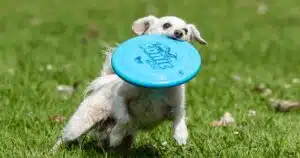
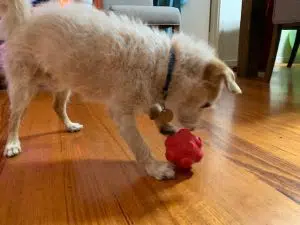
Brain games for dogs – Treat Treasure Hunt
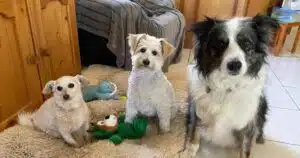
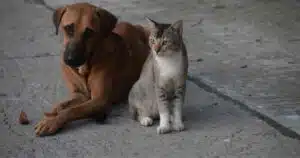
Debunking common dog and cat myths


Get your paws on Lara Shannon’s best selling books ‘Eat, Play, Love (your dog) and World of Dogs.
Available in Australia, USA, UK and Canada.